Human trafficking
- The unlawful recruitment, harboring and transportation of men, women and children for forced labor, sex exploitation, forced marriages, through coercion and fraud.
- Over one million people are exploited through human trafficking every year.
- Profitable business for both the traffickers, who could be either individuals or organized criminal groups such as Triads, Mafia, or Yakuza.
- Traffickers get their victims by either deceiving or misleading them through fake advertisements, mail-order catalogues etc. They then use blackmail, abuse, and threats to force victims to comply with their wishes in the destination country.
It refers to the unlawful recruitment, harboring and transportation of men, women and children for forced labor, sex exploitation, forced marriages, through coercion and fraud. Studies show that over one million people are exploited through human trafficking every year. This makes a profitable business for both the traffickers, who could be either individuals or organized criminal groups such as Triads, Mafia, or Yakuza.
Traffickers get their victims by either deceiving or misleading them through fake advertisements, mail-order catalogues etc. They then use blackmail, abuse, and threats to force victims to comply with their wishes in the destination country. Cases of human trafficking often go unreported because of the victims fall prey due to poverty and the absence of economic opportunities to earn a descent living. The destination countries of these victims also fail to report since they have the demand for various services that can be satisfied by these people (Rosenberg, 2004).
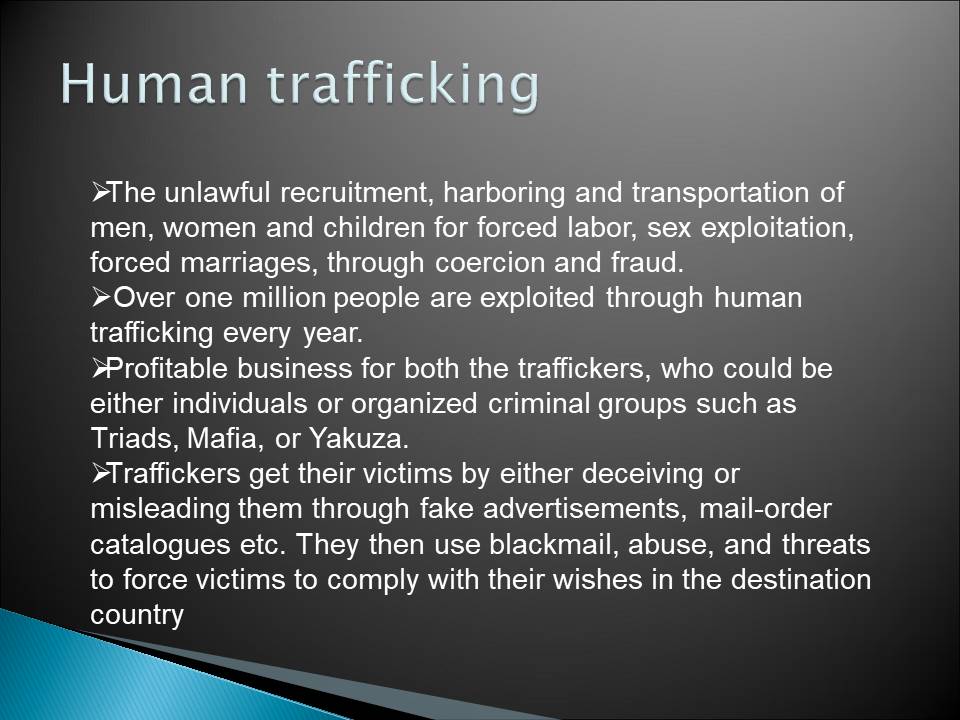
Human Trafficking is a global Affair
Routes are dependent on at least one documented case of human trafficking. Broken arrows represent transit points in transportation. Dominant destination countries are USA, Canada, France, Peru, Argentina, South africa. Dominant countries of origin include: Bolivia, Indonesia, China, Ethiopia, and Angola.
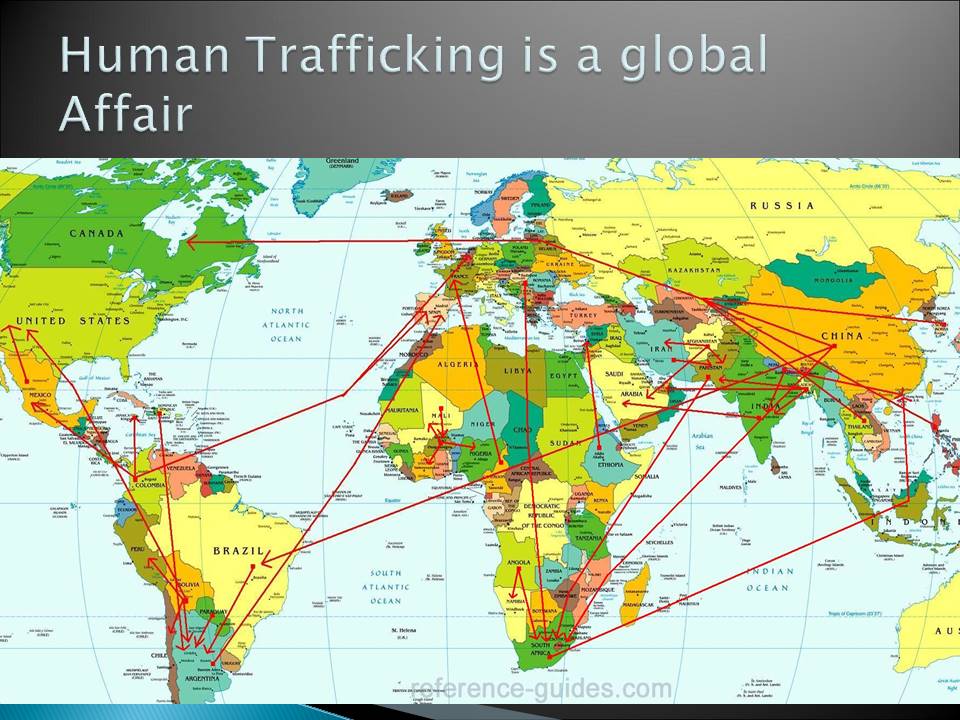
Causes of trafficking
- Poverty especially among women worldwide
- Inadequate education
- Inadequate employment
- Erosion of traditional family values
- Racial discrimination, racism and intolerance
- Media, new technologies, pornography
- Discrimination of women, male attitudes
- Economic disparities within countries
- Globalization and economic liberalisation
- Civil and military conflicts/military bases
- Transnational crime and weak law enforcement
- Corruption by police, law enforcers, officials
- Expanding commercial sex industry
Poor, weak and isolated people emerge from situations that cause disempowerment, social exclusion and economic vulnerability. This is due to inefficient policies and practices that marginalize entire groups of people and make them particularly vulnerable to being trafficked. Natural disasters, conflict and political turmoil weaken already tenuous social protection measures. Individuals are vulnerable to being trafficked not only because of conditions in their countries of origin, however. The allure of opportunity, the relentless demand for inexpensive goods and services and the expectation of reliable income drive people into potentially dangerous situations where they are at risk of being exploited (Rosenberg, 2004).
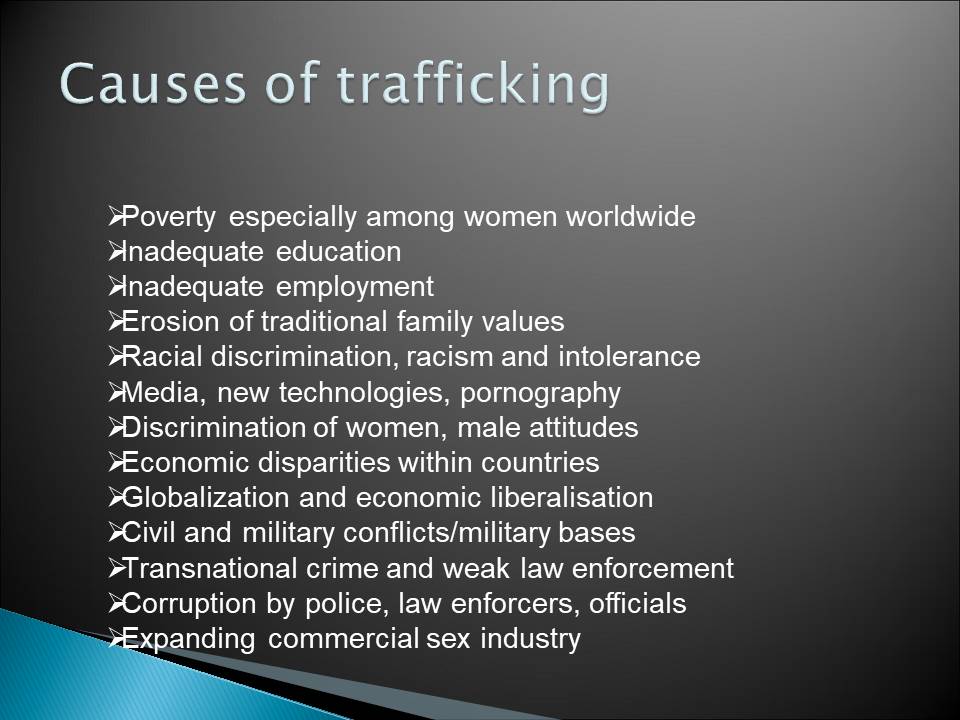
Human trafficking victims
The primary targets are women and children
They are targeted mostly because they are economically challenged causing them to be poor and unable to meet their daily needs, and they lack adequate education causing them to be gullible to the tricks used by traffickers. (poor, isolated and Weak).
- When they get to the destination countries, the victims
- Lose their passports to their traffickers to prevent them from escaping
- Are threatened (or their families)
- Bonded by debt
- Put to slave labor or married off
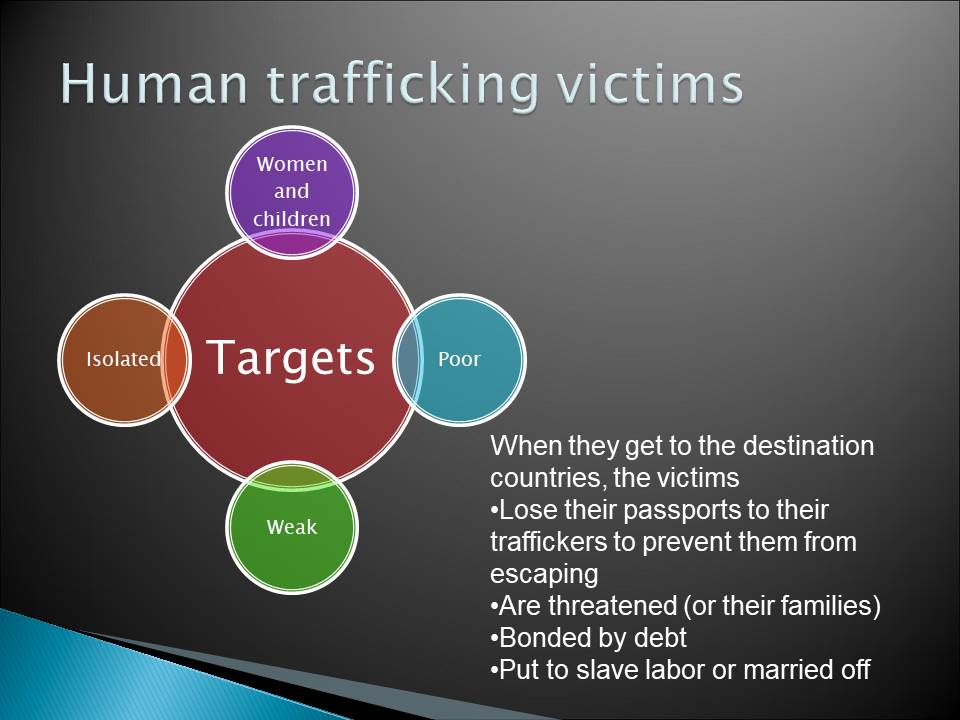
Trafficking facts
- A lot of money is made from human trafficking: it rivals that made from drug trafficking and illegal arms trade for the top criminal activity
- Trafficking is a $10 billion a year enterprise
- There are more human slaves today than when slavery was legal in the world
- It is estimated that 27,000,000 slaves exist in our world today
- Each year, 800,000 people are trafficked across international borders (Mattar, 2005).
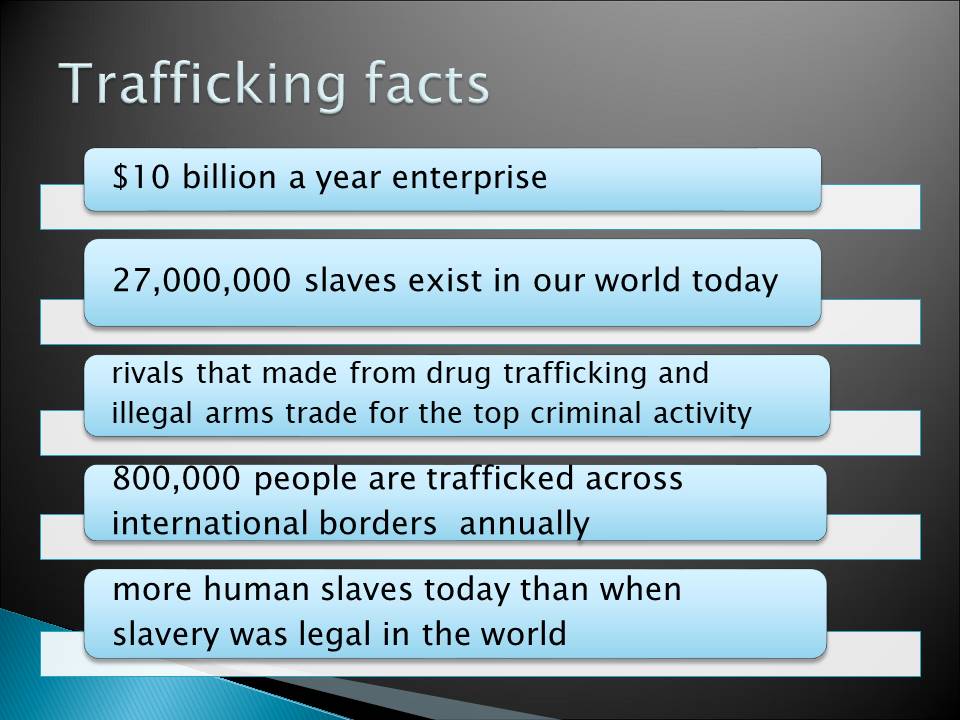
The human rights that are violated include
- The right to live, and to live in freedom and safety
- Right to freedom
- The rights to ask to be protected if someone attempts to violate you by harming your good name, entering your house, or bothering you or your family without a good reason
- Right to marry a person of your choosing
- The right to work, to be free to choose your work, to get a salary which allows you to support your family.
- Nobody has the right to treat you as his her slave and you should not make anyone your slave
- Nobody should force a person to marry
- If a man and a woman do the same work, they should get the same pay. All people who work have the right to join together to defend their interests (United Nations Office on Drugs and Crime, 2008).
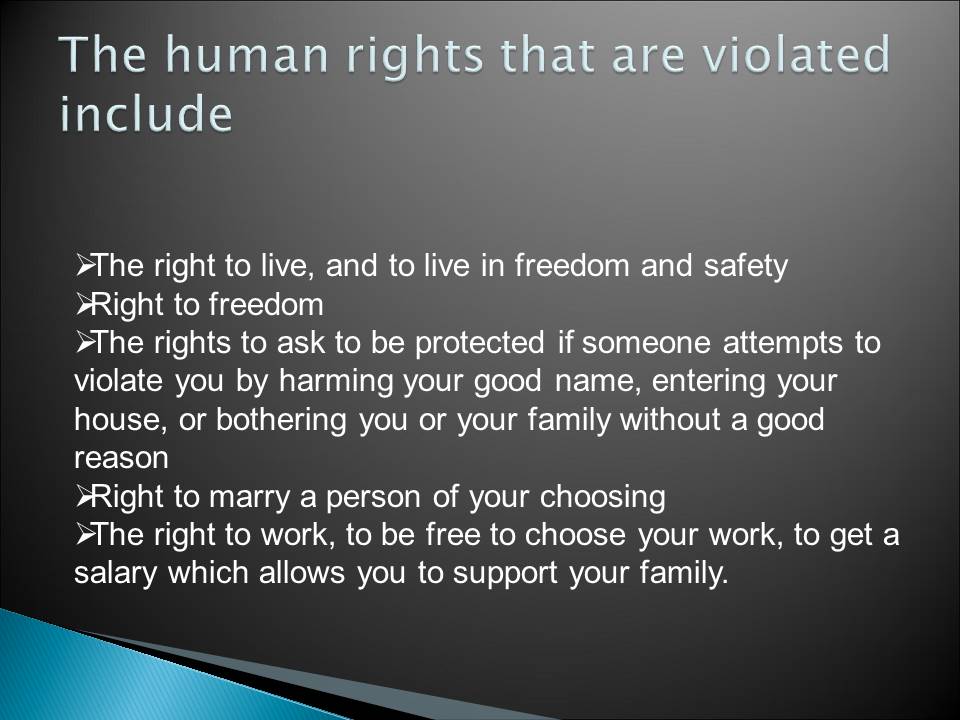
Case study: Sexual slavery
Victims exploited for sexual purposes:
- are used as prostitutes or sex slaves
- work 18 or more hours a day, 7 days a week
- Spend their time chained to beds
- Turned to be drug addicts in order to control them
- Exposed to physical violence from both traffickers and clients
Implications of sexual slavery include:
- Catch tuberculosis, AIDS/HIV or other sexually transmitted diseases
- Have other medical conditions due to their living/working conditions
- Suffer from post-traumatic stress syndrome
Prevalence of sexual slavery:
- Because of fear of AIDS/HIV, traffickers are selling young children to men for sexual purposes
- Extreme poverty causes parents in some developing countries to sell their daughters
- Women and children can be sold multiple times
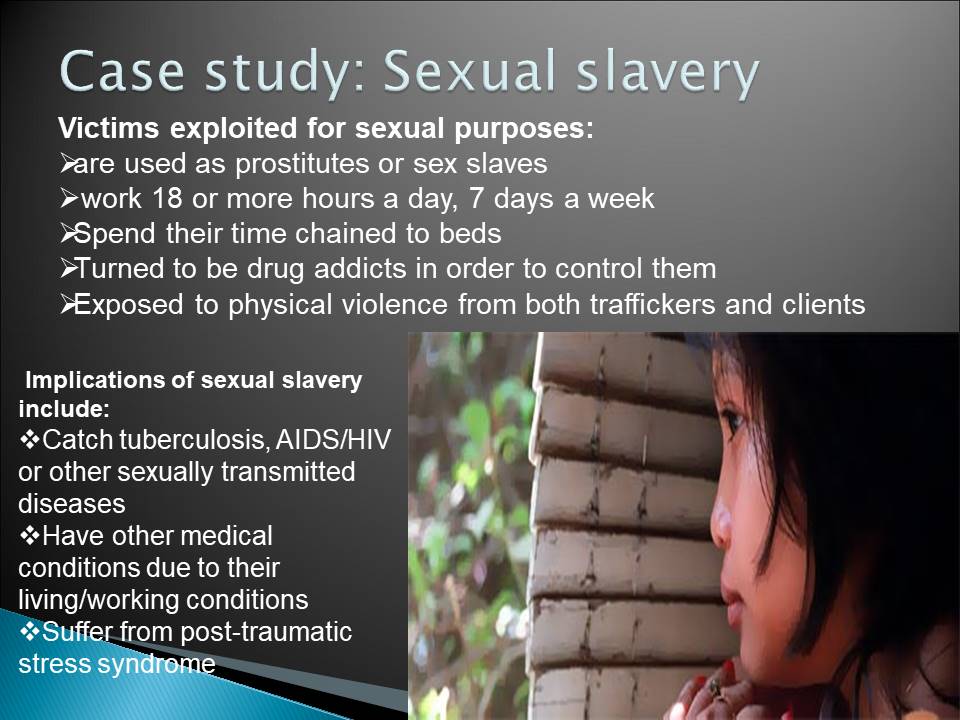
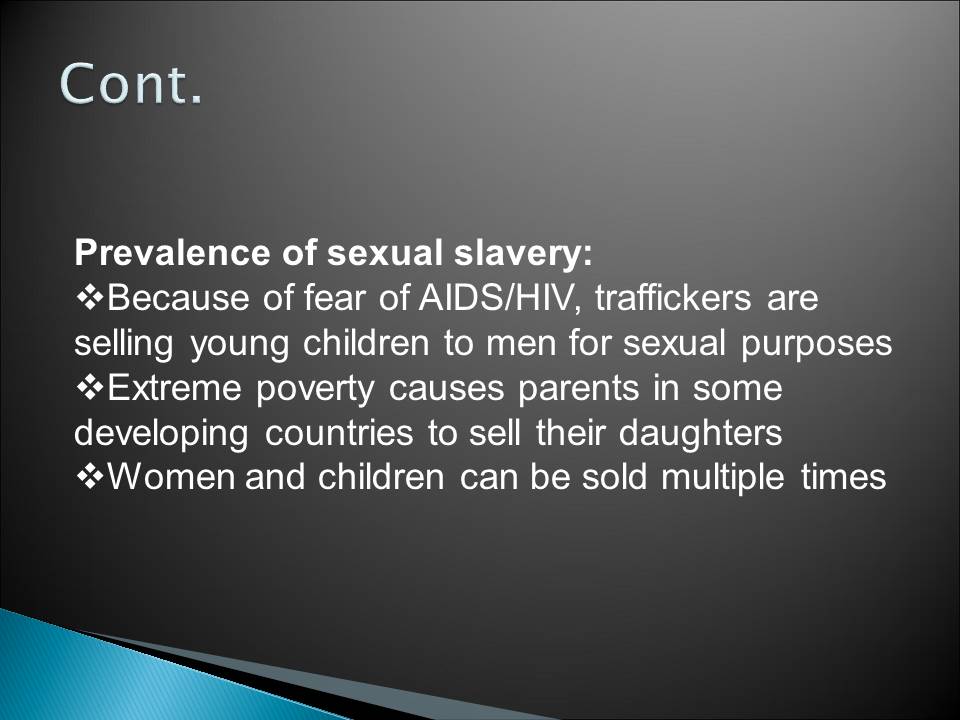
Case Study: Slave labor
Victims of slave labor are often:
- forced to work 18-20 hours a day, seven days a week in sweat shops, fields, construction, restaurants or domestic situations
- chained to their work stations or locked into rooms
- given no breaks and little food or water
- tricked into taking out a loan at extremely high interest rates to keep then tied to employer
- physically abused if they refuse to pay the high interest rates
- Boys as young as 6 are stolen from their villages to become soldiers in many countries.
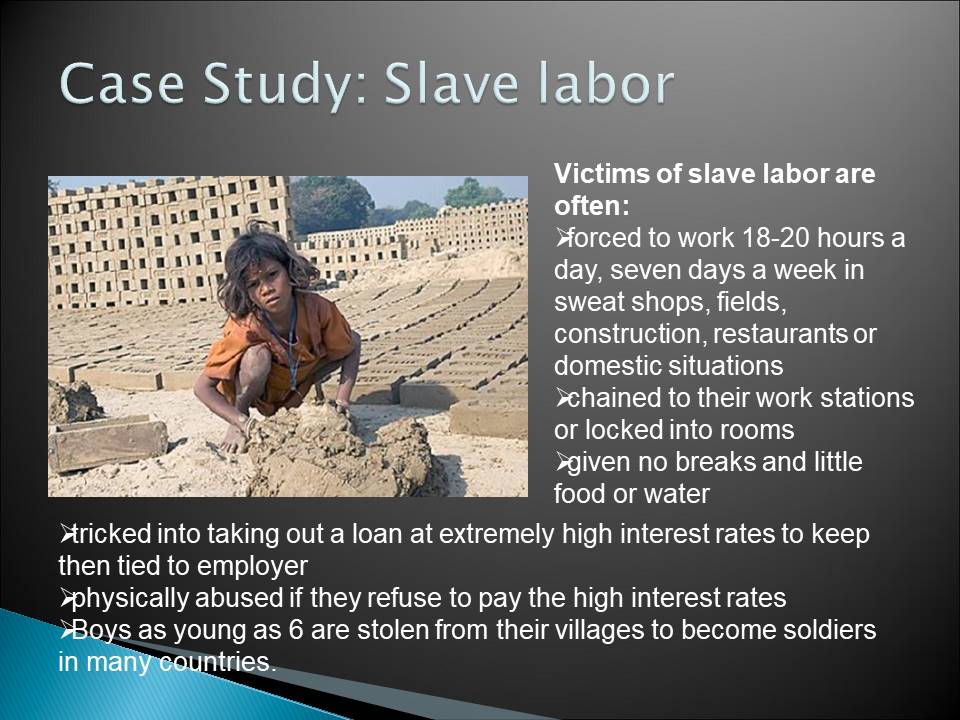
Case Study: Camel Racing in the United Arab Emirates
Many are sexually abused. They are lonely and overworked.
- Close to 40,000 children Pakistan, Bangladesh and Sudan, are trafficked to the United Arab Emirates.
- They work as camel jockeys are starved to keep them small and light for racing; many are injured and dozens are killed each year when the camels stampede.
Due to the popularity of camel racing as a sport in the UAE, close to 40,000 children Pakistan, Bangladesh and Sudan, are trafficked to the United Arab Emirates. Even two year old children are abducted ot sold by their families to traffickers due to extreme poverty in these countries.
These children, who work as camel jockeys are starved to keep them small and light for racing; many are injured and dozens are killed each year when the camels stampede; because they are illegal immigrants, their owners never take them to hospital leaving many children permanently handicapped. The United Nation’s attempts to ban the Bedouin sport have been unfruitful due to its popularity (Bales, 2005).
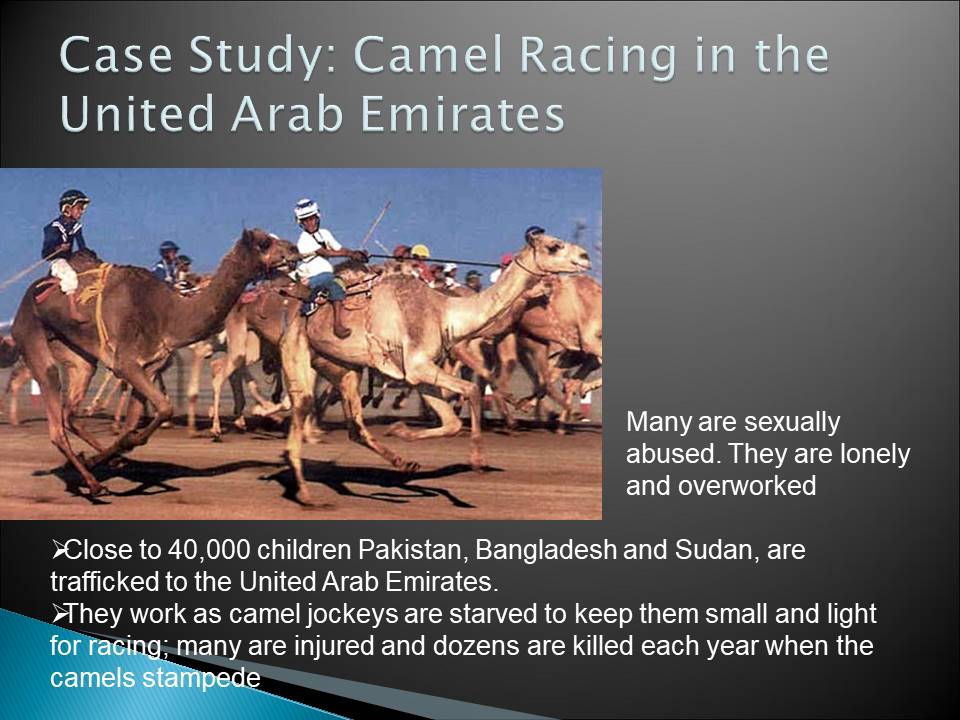
Video
Robots replace children as camel jockeys in UAE. Web.

Attempts to solve the problem
- Agreements between the UAE and UN bodies: one such agreement between the UAE and UNICEF makes it illegal for race clubs to use jockeys younger than 15 or weighing less than 45 kilos.
- Setting up jockey rehabilitation centers: they provide education and healthcare for the children. There is a $2.7 million pledge by UNICEF and UAE to integrate jockeys back into the society by teaching them etiquette and how to live with people peacefully.
- Efforts to re-unite jockeys with their families: this is a difficult exercise conducted by authorities since most children have no recollection of their families or where they lived, causing them to result to DNA tests in some cases.
- Modernization of the sport: The Middle Eastern Gulf state of Qatar is developing robot jockeys to replace the heavily criticized use of children (Bales, 2005).
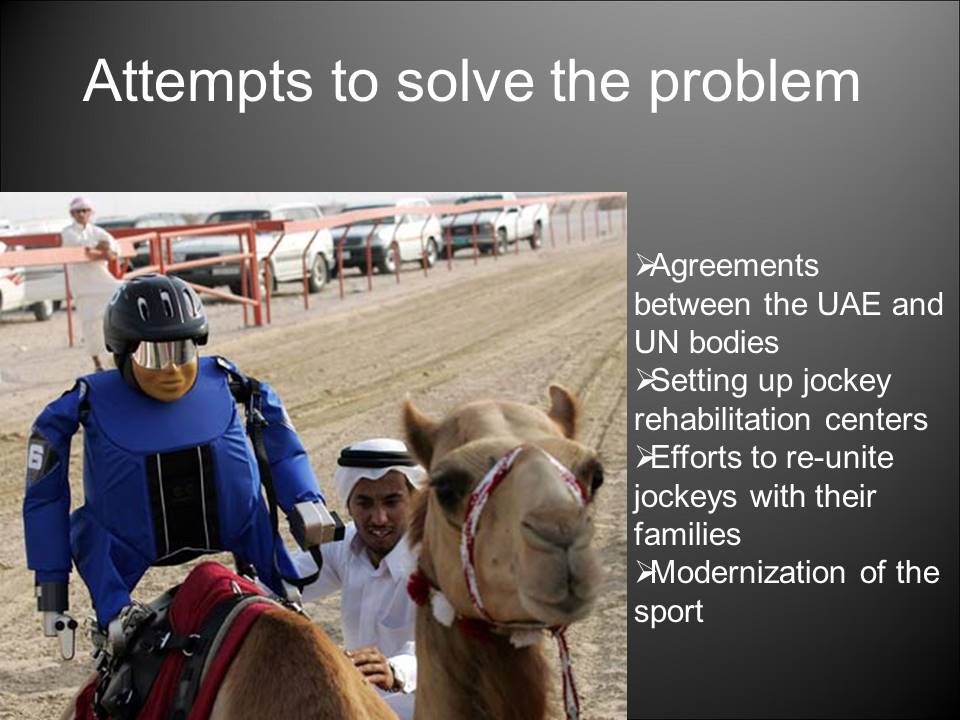
My Position: role of the state
Individual countries should establish laws criminalizing human trafficking, ensure heavy penalties for the offense, and enforce the laws by investigating, prosecuting and convicting traffickers.
- Law enforcement: the States should exchange information with each other, train their police and courts in prevention, investigation, and human rights;
- Victim protection: the States should ensure privacy, safety, information on proceedings and safe repatriation
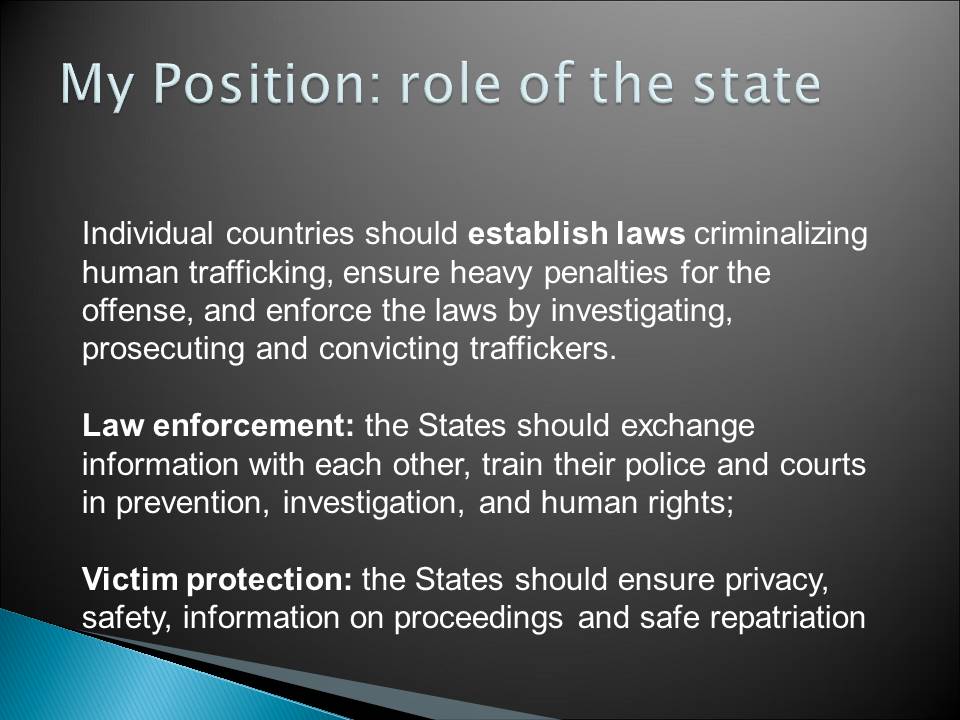
Recommendations
Various religions including Christianity, Judaism, Buddhism, Islam, and Hinduism treasure a common rule that one should do to others what they wish to be done to themselves (Mattar, 2005). As such, religious groups should intervene in the trafficking problem in order to bring to a halt the physical, emotional, and financial abuse that the victims are exposed to. In addition to this, both government and non-government bodies should unite in raising awareness about trafficking. Citizens can lobby the governments to enforce laws and policies that do not marginalize the poor and economically vulnerable groups. The government should also discourage the absorption of trafficking victims by promoting fair trade that allows industries to pay their employees well. Lastly, the UN trafficking protocol should be implemented to the full, as it contains a comprehensive strategic approach for fighting human trafficking. This can be achieved by employing measures that provide clarity and systematic tackling of the issue in order to achieve sustainable action.
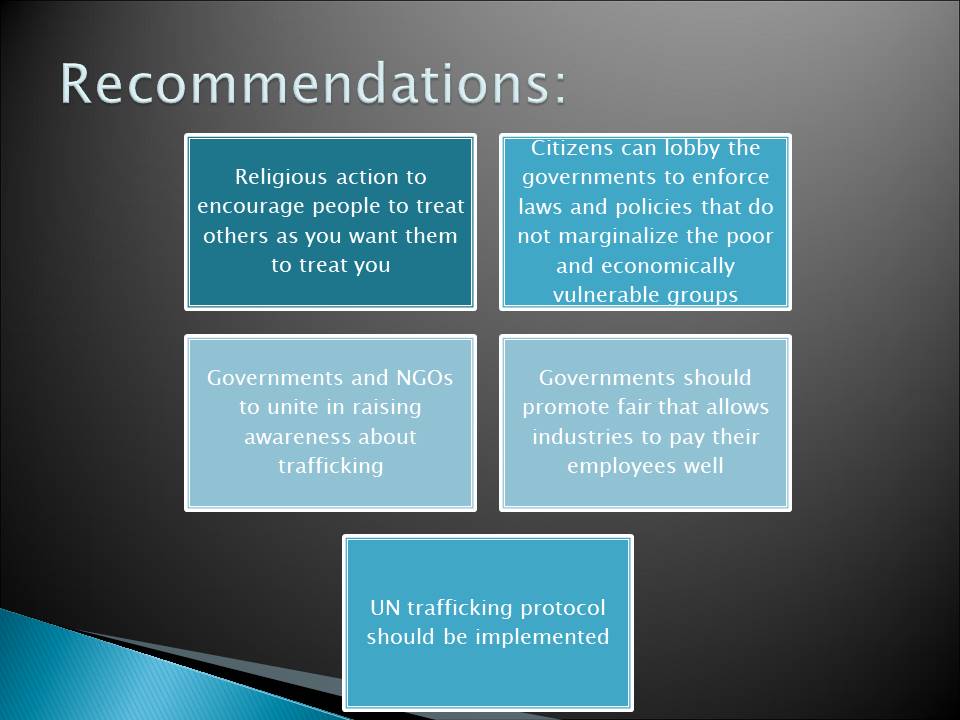
References
Bales, K. (2005). Understanding Global Slavery: a Reader. Berkeley, California: University of California Press.
Mattar, M. Y. (2005). Incorporating the five basic elements of a model anti-trafficking in persons legislation in domestic laws: from the United Nations Protocol to the European Convention. Tulane Journal of International and Comparative Law, 14(2), 385.
Rosenberg, R. (2004). Best Practices for Programming to Prevent Trafficking in Human Beings in Europe and Eurasia. Bethesda, Maryland: Development Alternatives Inc.
UN.GIFT. (2008). An Introduction to Human Trafficking: Vulnerability, Impact and Action. New York: United Nations Global Initiative to Fight Human Trafficking.
United Nations Office on Drugs and Crime. (2008). Trafficking in Persons: Global Patterns. Vienna: United Nations.